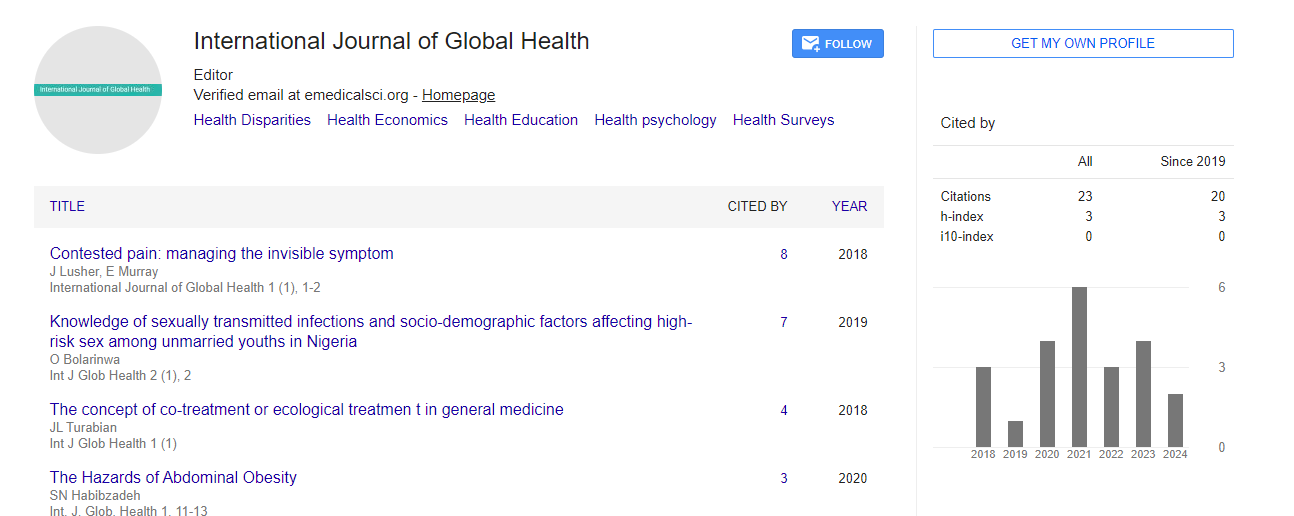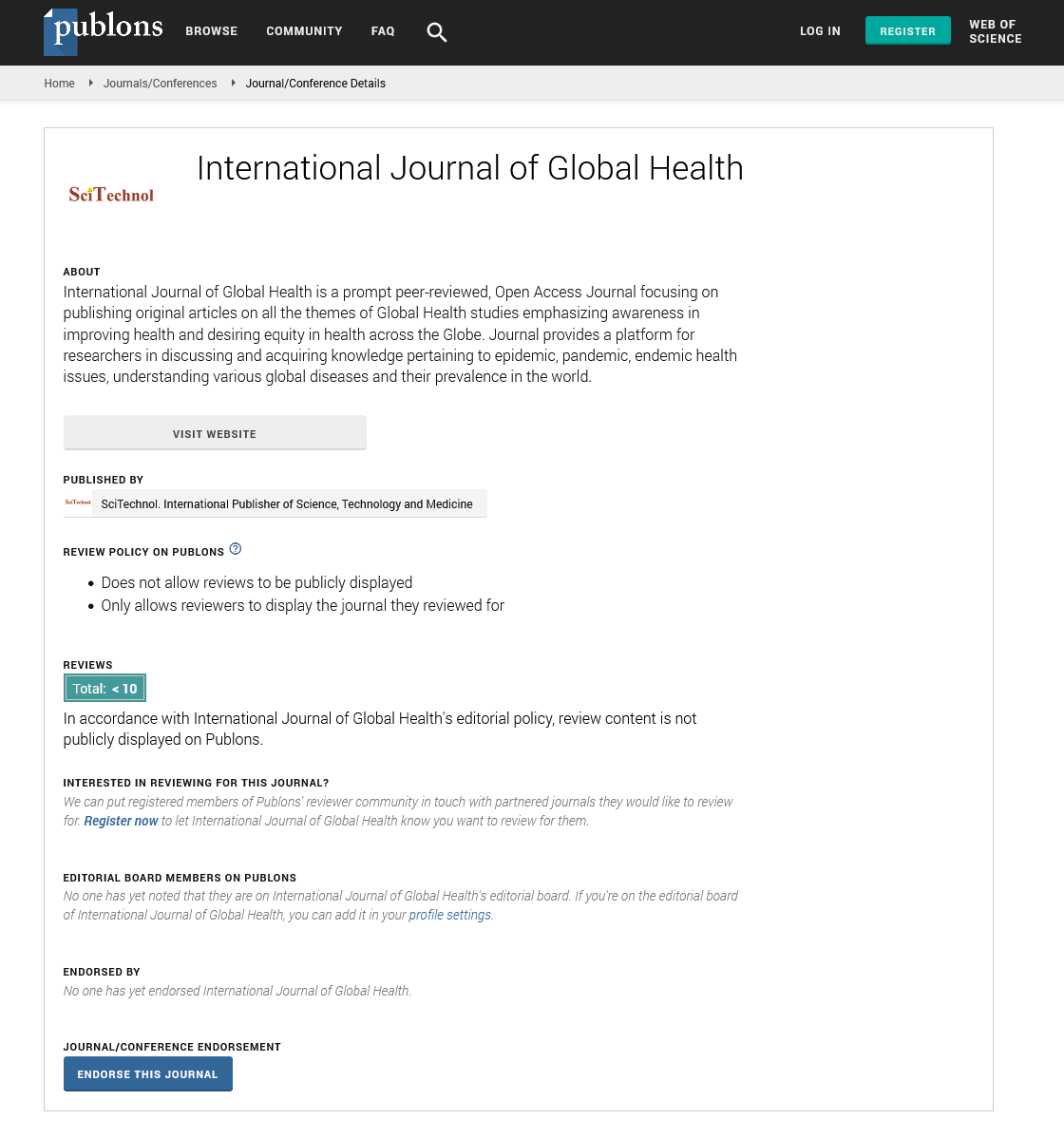Perspective, Int J Glob Health Vol: 7 Issue: 3
Biostatistical Methods for Assessing the Impact of Non-Communicable Diseases Worldwide
Elena Costa*
1Department of Public Administration, Vytautas Magnus University, Kaunas, Lithuania
*Corresponding Author: Elena Costa,
Department of Public Administration,
Vytautas Magnus University, Kaunas, Lithuania
E-mail: elena.costa@vmu.lt
Received date: 28 August, 2023, Manuscript No. IJGH-23-116159;
Editor assigned date: 30 August, 2023, PreQC No. IJGH-23-116159 (PQ);
Reviewed date: 13 September, 2023, QC No. IJGH-23-116159;
Revised date: 21 September, 2023, Manuscript No. IJGH-23-116159 (R);
Published date: 29 September, 2023, DOI: 10.4172/Ijgh.1000190
Citation: Costa E (2023) Biostatistical Methods for Assessing the Impact of Non-Communicable Diseases Worldwide. Int J Glob Health 6:3.
Description
Non-Communicable Diseases (NCDs) represent a formidable global health challenge. These diseases, including heart disease, cancer, diabetes, and chronic respiratory diseases, account for a significant portion of global mortality and morbidity. Understanding the impact of NCDs worldwide is essential for effective public health planning and intervention strategies. Biostatistical methods play a vital role in assessing and quantifying this impact, allowing policymakers and healthcare professionals to make informed decisions.
Descriptive epidemiology
Prevalence and incidence: Biostatisticians calculate the prevalence (the proportion of individuals with a specific NCD at a given time) and incidence (the number of new cases of the NCD occurring in a specific period) to estimate the disease burden.
Mortality rates: Mortality rates provide insights into the number of deaths attributed to NCDs, helping assess their impact on overall mortality.
Disability-Adjusted Life Years (DALYs): DALYs combine information on years of life lost due to premature death and years lived with disability. They provide a comprehensive measure of the burden of NCDs.
Analytical epidemiology
Risk factor assessment: Biostatisticians use case-control studies, cohort studies, and cross-sectional surveys to identify and quantify the risk factors associated with NCDs. This information helps design preventive strategies.
Attributable fraction: Attributable fraction calculations estimate the proportion of NCD cases that can be attributed to specific risk factors, such as smoking or poor diet.
Survival analysis: Survival analysis techniques, including Kaplan-Meier survival curves and Cox proportional hazards models, assess the prognosis and survival outcomes of individuals with NCDs.
Spatial epidemiology
Geographical mapping: Geographic Information Systems (GIS) and spatial statistics help develop maps and identify geographic patterns of NCD prevalence, aiding in targeting interventions.
Cluster analysis: Cluster analysis identifies areas with unusually high or low NCD rates, suggesting potential environmental or local risk factors.
Meta-analysis
Combining data: Meta-analysis pools data from multiple studies to provide more robust estimates of NCD prevalence, risk factors, and intervention effectiveness.
Quantifying heterogeneity: Biostatisticians use statistical methods to assess and quantify heterogeneity among study results.
Time-series analysis
Trend analysis: Time-series analysis assesses the temporal trends of NCDs, helping identify patterns and changes over time.
Seasonal variations: These methods detect seasonal variations in NCD occurrence, such as increased respiratory illness during the winter months.
Cost-effectiveness analysis
Economic impact assessment: Biostatistical models evaluate the economic impact of NCDs, considering direct healthcare costs, indirect costs, and lost productivity.
Cost-effectiveness of interventions: Biostatistical analysis helps assess the cost-effectiveness of various interventions, such as vaccination programs, tobacco control policies, or lifestyle interventions.
Machine learning and predictive modeling
Predicting NCD trends: Machine learning algorithms analyze large datasets to predict future NCD trends, identify high-risk populations, and inform early intervention strategies.
Risk stratification: Predictive models categorize individuals into risk groups based on various factors, enabling personalized preventive approaches.
Causal inference
Causal relationships: Biostatistical methods aim to establish causal relationships between risk factors and NCDs, using approaches like propensity score matching or instrumental variable analysis.
Health inequalities: Biostatisticians analyze data to identify health disparities related to NCDs, including variations in disease burden among different populations and regions.
Subgroup analysis: Subgroup analysis assesses how NCD impact varies among demographic groups, helping target interventions.
Health survey design and analysis
Sampling methods: Biostatisticians design health surveys, select representative samples, and employ statistical techniques to draw valid inferences about NCD prevalence and risk factors.
Conclusion
Biostatistical methods are indispensable for assessing the impact of non-communicable diseases worldwide. These methods provide the means to collect, analyze, and interpret data on NCD prevalence, risk factors, outcomes, and economic implications. By leveraging biostatistical tools, global health stakeholders can develop evidence-based policies and interventions to mitigate the impact of NCDs and improve public health on a global scale.
 Spanish
Spanish  Chinese
Chinese  Russian
Russian  German
German  French
French  Japanese
Japanese  Portuguese
Portuguese  Hindi
Hindi 
